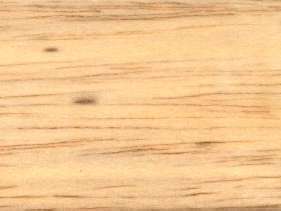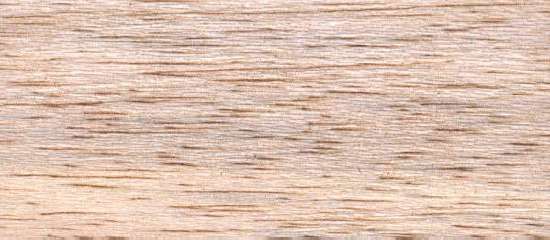 
Balsa (Ochroma pyramidale)
Family: Bombacaceae
Common names: Algodon, Balsa, Balsa real, Balso, Bob-wood, Bois flot, Bois liege, Bois lievre, Bois pripri, Bombast mahoe, Burillo, Cajeto, Cajote, Ceiba de lana, Ceibon botija, Ceibon lancro, Ceibon lanero, Corcho, Corkwood, Coton fleurs, Cotton fleurs, Cottontree, Doon-tree, Down tree, Dum, Dun, Duras, Enca, Enea, False cork tree, Fromager mapou, Gatillo, Gonote real, Guano, Hembra, Huampo, Jujul, Lana, Lanero, Lanilla, Lano, Macho, Mahaudeme, Maho, Manhot a grandes feulles, Mo-ma-ah, Palo de balsa, Palo de lana, Pata de lebre, Patte de lievre, Patte lapin, Pau de balsa, Pau de jangada, Piu, Pochote, Polak, Puero, Puh, Pung, Quattier, Tacariqua, Tambor, Tami, Tauri, Topa, Tucumo, Uru
Distributed in: Bahamas, Bolivia, Brazil, Colombia, Columbia, Costa Rica, Cuba, Dominican Republic, Ecuador, Fiji [Polynesia], Fiji, Guatemala, Haiti, Honduras, India, Indonesia, Jamaica, Malaysia, Mexico, Nicaragua, Panama, Papua New Guinea, Peru, Philippines, Puerto Rico [US], Puerto Rico, Sri Lanka, Trinidad and Tobago, Venezuela (Central America, Latin America, Oceania and S.E. Asia)
Distribution overview: The geographical range of Balsa includes the Cape Verde Islands. It is also widely distributed in tropical America (with minor varieties distinguished as species by some authors). The tree grows in the Greater and Lesser Antilles, from St. Kitts to Grenada, and Trinidad & Tobago. It is also found from southern Mexico to Ecuador, Peru, Bolivia, and Brazil, and is planted in southern Florida and Dutch West Indies. It is typically found at lower elevations, particularly on bottom-land soils beside streams. It also grows on clearings and cutover forests, and is cultivated on plantations
Common uses: Baskets, Boards, Boat building, Boat building: framing, Boxes and crates, Canoes, Caskets, Chemical containers, Core Stock, Door, Dressed boards, Drum sticks, Fishnet floats, Floats, Food containers, Insulating boards, Lifeboats, Light construction, Lumber, Model airplanes, Musical instruments , Novelties, Organ pipes, Paneling, Piano keys, Pianos , Plywood corestock, Plywood, Posts, Pulp/Paper products, Rough boards/dimension stock, Shipbuilding, Sounding boards, Specialty items, Sporting Goods, Toys, Truck bodies, Turnery, Vehicle parts, Veneer, Violin bows, Violin, Xylophones
Product sources: The ITTO reports that the species is a fairly important source of timber in Ecuador, and is exported regularly. The natural range of Balsa is very extensive, it grows very rapidly, and is widely cultivated on plantations, all of which contribute to the abundance of Balsa. Price is rated as fairly expensive per board foot, but since its normal uses usually require small quantities of the material, the price is often an insignificant factor.
Environment profile: Abundant
Tree size: Trunk diameter is 100-150 cm
Colors: the heart isWhite to cream, Yellowand the sapwoodYellow, Yellowish.The grain isWeak figure, the textureMedium coarse to coarseand the lusterSlightly lustrous
Natural durability: Very durable, Vulnerable to attack by beetles and dry-wood termites
Odor: No specific smell or taste
Kiln Schedules: UK=H US=T10D4S/T8D3S Fr=7
Kiln Drying Rate: Slow
Drying Defects: Slight twist/warp, Splitting
Ease of Drying: Thick Stock Requires Care
Tree Identification: Bole/stem form is buttressed
Comments: General finishing qualities are rated as good General finishing qualities are rated as satisfactory
Blunting Effect: Slight dulling effect on cutting tools
Boring: Poor to very poor results
Carving: Poor to Very Poor Results
Cutting Resistance: Low cutting resistance
Gluing: Satisfactory gluing properties
Mortising: Poor to Very Poor
Moulding: Poor to Very Poor
Movement in Service: Poor to Very Poor
Nailing: Poor to Very Poor , Pre-Boring Recommended
Planing: Very Good to Excellent
Resistance to Impregnation: Sapwood is permeable
Resistance to Splitting: Excellent
Response to hand tools: Responds well to hand tools
Routing recessing: Poor to Very Poor Results
Sanding: Satisfactory sanding results
Veneering qualities: Veneers easily, Veneers moderately easy
Steam bending: Very poor
Screwing: Poor results, Poor screw holding properties ; Turning: Very Good to Excellent Results
Painting: Poor; Polishing: Very Good to Excellent; Staining: Finish is generally satisfactory;
- Numerical data Metric
- Numerical data English
- Strength properties
- References
 |
 |
 |
 |
| Item |
Green |
Dry |
Metric |
| Specific Gravity |
0,09 |
0,12 |
|
| Density |
|
144 |
kg/m3 |
| Bending Strength |
246 |
387 |
kg/cm2 |
| Crushing Strength |
26 |
49 |
kg/cm2 |
| Hardness |
|
147 |
kg |
| Impact Strength |
|
38 |
cm |
| Shearing Strength |
|
62 |
kg/cm2 |
| Stiffness |
59 |
75 |
1000 kg/cm2 |
| Tangential Shrinkage |
7 |
|
% |
| Radial Shrinkage |
3 |
|
% |
| Weight |
160 |
128 |
kg/m3 |
| Maximum Load |
|
|
cm-kg/cm3 |
| Toughness |
|
183 |
cm-kg |
| Static Bending |
185 |
319 |
kg/cm2 |
|
 |  |  |  | | Item | Green | Dry | English | | Bending Strength | 3513 | 5511 | psi | | Crushing Strength | 377 | 701 | psi | | Density | | 9 | lbs/ft3 | | Hardness | | 325 | lbs | | Impact Strength | | 15 | inches | | Maximum Crushing Strength | 2061 | 2990 | psi | | Shearing Strength | | 882 | psi | | Static Bending | 2634 | 4544 | psi | | Stiffness | 853 | 1076 | 1000 psi | | Toughness | | 159 | inch-lbs | | Specific Gravity | 0.09 | 0.12 | | | Weight | 10 | 8 | lbs/ft3 | | Radial Shrinkage | 3 | | % | | Tangential Shrinkage | 7 | | % | | Volumetric Shrinkage | 10 | | % | |
Density (dry weight) = < 15 lbs/cu. ft. 0
Bending strength (MOR) = very low 0
Max. crushing strength (stiffness) = very low 0
Modulus of Elasticity (stiffness) = very low 0
Shrinkage, Radial = very small 0
Shrinkage, Tangential = moderate 0
Shearing strength (parallel to grain) = very low
Hardness (side grain) = very soft
Shrinkage, Volumetric = moderate
Shrinkage, Tangential = very small
Shrinkage, Tangential = small
Shrinkage, Radial = small
Density (dry weight) = 15-22 lbs/cu. ft.
Shrinkage, Radial = moderate
Toughness-Hammer drop (Impact Strength) = very low
Shrinkage, Volumetric = small
Shrinkage, Tangential = large
Shrinkage, Tangential = fairly large
Shrinkage, Radial = large
Shrinkage, Radial = fairly large
Max. crushing strength = low
Density (dry weight) = 23-30 lbs/cu. ft.
Compression strength (parallel to grain) = low
Bending strength (MOR) = low
Balsa is described as the lightest and softest hardwood on the market, with the sapwood constituting most of the commercial lumber. Although Balsa is very weak overall, its strength properties are high in relation to its weight. Balsa is about twice as strong as Spruce in compression parallel to grain, on a strength-to-strength basis.
Acosta-Solis, M.,1960,Maderas Economicas del Ecuador y sus Usos,Editorial Casa de la Culhra Ecuatoriana QuitoArno, J. 1988. Ochroma pyramidale - Balsa. In A Guide to seful Woods of the World. Flynn Jr., J.H., Editor. King Philip Publishing Co., Portland, Maine. 1994. Page 246-247.Berni, C.A., Bolza, E., Christensen, F.J.,1979,South American Timbers - The Characteristics, Properties and Uses of 190,Species,C.S.I.R.O Div. Building ResearchBolza, E.,1975,Properties and Uses of 175 Timber Species from Papua New Guinea and West,Irian,C.S.I.R.O. Div. Building Research Report,no.34Boone, R.S., C.J. Kozlik, P.J. Bois, E.M. Wengert. 1988. Dry Kiln Schedules for Commercial Hardwoods - Temperate and Tropical. USDA, Forest Service, General Technical Report FPL-GTR-57, Forest Products Laboratory, Madison, Wisconsin.Brown, W.H.,1969,Properties and uses of Tropical hardwoods in the United Kingdom. Part 1,Nonstructural properties and uses.,Conference on Tropical hardwoods SC-5/TN-5, Syracuse UniversityBrown, W.H.,1978,Timbers of the World, No. 2 South America,TRADA, Red Booklet SeriesBrush, W.D.,1945,Balsa (Ochroma lagopus,U.S.A. Department of Agriculture, Forest Products Laboratory, Madison,,Foreign Woods SeriesChudnoff, M.,1984,Tropical Timbers of the World,U.S.A. Department of Agriculture, Forest Service, Forest Products,Laboratory, Madison.Clifford, N.,1953,Commercial Hardwoods - Their Characteristics Identification and,Utilization,Sir Isaac Pitman & Sons Ltd. LondonConstantine, Jr., A. J. 1959.Know Your Woods - A Complete Guide to Trees, Woods, and Veneers.Revised Edition.Revised by H.J. Hobbs.Charles Scribner's Sons, New York.Erfurth, T., Rusche, H.,1976,The Marketing of Tropical Wood B. Wood Species from S. American Tropical,Moist Forests,F.A.O. Forestry DepartmentFarmer, R.H.,1972,Handbook of Hardwoods,HMSOFindlay, W.P.K.,1975,Timber: Properties and Uses,Crosby Lockwood Staples London,224PPForest Products Research Laboratory, U.K.,1945,A Handbook of Empire Timbers,Department of Scientific and Industrial Research Forest Products ResearchForestry Commission of New South Wales,1987,Timbers used in New South Wales for Domestic Buildings,Forestry Commission of New South Wales, Technical Publication No.6Forests Products Research Laboratory, U.K.,1956,A Handbook of Hardwoods,Forest Products Research Laboratory, Princes Risborough, Department of,Science and Industrial Research, Building Research EstablishmentFors, A.J.,1965,Maderas Cubanas,Inst. Nac. Ref. Agraria La HabaraHoward, A.L.,1948,A Manual of Timbers of the World.,Macmillan & Co. Ltd. London 3rd ed.Kaiser, J.Wood of the Month: Balsa - The Lightweight Wood.Wood & Wood Products, July, 1988.Page 102.Keating, W.G., Bolza, E.,1982,Characteristics properties and uses of timbers. South East Asia, Northern,Australia and the Pacific,C.S.I.R.O. Div. Chemical Technology,Inkata Press,1Kloot, N.H., Bolza, E.,1961,Properties of Timbers Imported into Australia,C.S.I.R.O. Forest Products Division Technological Paper,No.12Kukachka, B.F.,1970,Properties of Imported Tropical Woods,Forest Research Paper FPL 125Lauricio, F. M., Bellosillo, S. B., The Mechanical and Related Properties of Philippine Woods, The Philippine Lumber Journal, 12(5):A-H.Limaye, V.D. and B.R. Sen. 1956. Weights and Specific Gravities of Indian Woods. Indian Forest Records (New Series). Timber Mechanics. Volume 1 No. 4. Manager of Publications (Publisher, Delhi.Lincoln, W.A. 1986. World Woods in Color. Linden Publishing Co. Inc., Fresno, California.Little, E.L., Wadsworth, F.H.,1964,Common Trees of Puerto Rico and the Virgin Islands,U.S.A. Department of Agriculture, Agriculture Handbook,No.249Little, E.L.,1948,A Collection of Tree Specimens from Western Ecuador,Caribbean Forester,9(3,pp215-98Longwood, F.R.,1961,Puerto Rican Woods - Their Machining Seasoning and Related Characteristics,U.S.A. Department of Agriculture, Agriculture Handbook,No.205Longwood, F.R.,1962,Commercial Timbers of the Caribbean,U.S.A. Department of Agriculture, Agriculture Handbook,No.207Loureiro, A.A., Freitas da Silva, M.,1968,Catalogo das Madeiras da Amazonia (2 vols,Min. do Ultramar Belem BrasilMarshall, R.C.,1934,Trees of Trinidad and Tobago,Government Printer Port of Spain TrinidadMarshall, R.C.,1939,Silviculture of the trees of Trinidad and Tobago - British West Indies,O.U.P.,LondonNazma,1981,A handbook of Kerala Timbers,Kerala Forest Research Institute Research Report, No.9Patterson, D.,1988,Commercial Timbers of the World, 5th Edition,Gower Technical PressRatliff, E.K.,1946,Balsa (Ochroma lagopus,Wood,11(12,PP339-41Record, S.J., Hess, R.W.,1943,Timbers of the New World,Yale University PressRedding, L.W.,1971,Resistance of Timbers to Impregnation with Creosote,Forest Products Research Laboratory, Princes Risborough, Building Research,Establishment Bulletin No.54 pp.43Rendle, B.J.,1969,World Timbers (3 Vols.,Ernest Benn Ltd. LondonReyes, L.J.,1938,Philippine Woods,Commonwealth of the Philippines Department of Agriculture and Commerce,Technical Bulletin,No.7Schiffino, J.,1945,Riqueza Forestal Dominicana (Three volumes,Secretaria de Estado de Agric. Ind. y TrabajoSmith, D.N.,1959,The Natural Durability of Timber,Forest Products Research Laboratory, Princes Risborough, Building Research,Establishment Record,No.30Streets, R.J.,1962,Exotic Forest Trees in the British Commonwealth,Clarendon Press OxfordSwabey, C.,1941,The Principal Timbers of Jamaica,Department of Science and Agriculture Jamaica Bulletin No.29Takahashi, A.,1975,Compilation of data on the Mechanical Properties of Foreign Woods (Part 2,Central and South America,Shimane University, Japan, Research Report on Foreign Wood No.4Tewari, M.C., Jain, J.C.,1980,Utilization of Secondary Species,Journal of the National Building Organization 25(2) pp1-6Timber Development Association Ltd.,1948,Notes on Ecuadorian Timbers,TRADA, Timber Information,35,pp5Timber Development Association,1948,Some New Timbers and Their Uses No. 34,Timber Development Association Limited, London [TRADA]U.S.D.A. Forest Service,1974,Wood Handbook,U.S.A. Department of Agriculture, Forest Service Handbook,72USDA. 1987. Wood Handbook:Wood as an Engineering Material. Agriculture Handbook No. 72. United States Department of Agriculture, Forest Service, Madison, Wisconsin.Venezuela-Laboratories Nacional de Productos Forestates,1974,Caraderisticas, Propiedades y usos de 104 Maderas de los allos Ilanos,occidentales,Min. Ag. y Cria, Universidad de Los andes, Merida, Venezuela Lab.Nac. de,Prod. For.Villamil, F.G.,1971,Maderas Colombianas,Proexpo ColombiaVolkart, C.,1965,Recopilacion dedatos sobre propiedacies y usos maderos del Bosque Tropical,de las Costa Atlantica de Nicaragua,Turrialba,15(1, pp43-57WCMC. 1992. Conservation Status Listing - Trees and Timbers of the World. World Conservation Monitoring Center-Plants Programme, Cambridge, CB3 ODL, United Kingdom.Woods, R.P.,1949,Timbers of South America,TRADA, Red Booklet SeriesWyatt-Smith, J.,1928,Costa Rican Balsa (Ochroma lagopus,Tropical Woods,2(15,PP34-7
|









